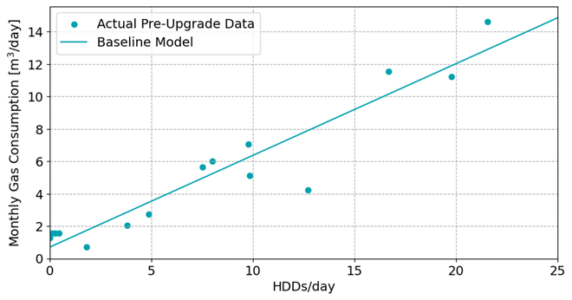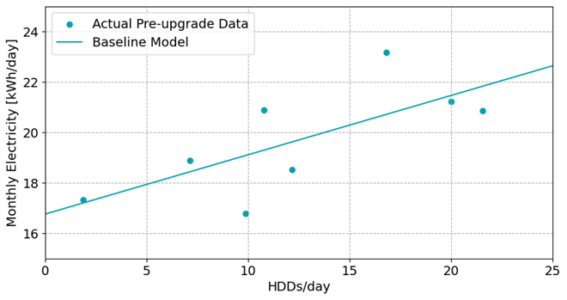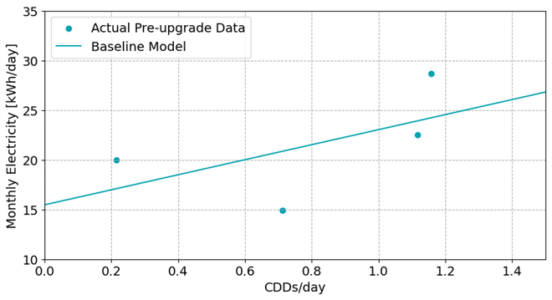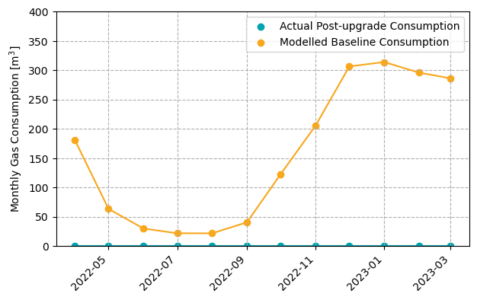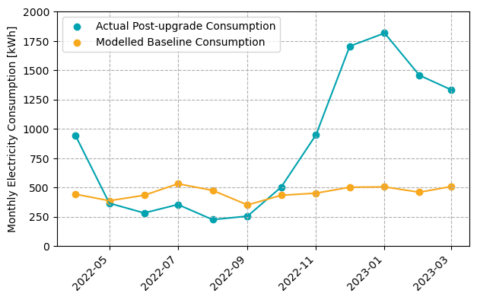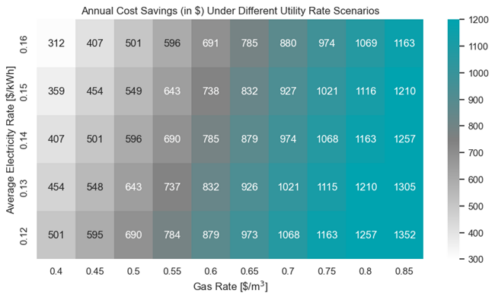
Home Heat Pump Case Study 6: Fully-Electrified Home
Published Online September 2023
Summary
Imagine making energy-efficient improvements to your home that not only enhance your comfort but also reduce your utility bills and environmental impact. In this case study, we explore the transformation of a Toronto home through a series of upgrades, including better insulation, air-sealing, and the installation of high-efficiency heat pumps both for space heating/cooling and water heating.
The combined impact of all upgrades in the case study home was large. Analysis of pre- and post-installation utility bills covering one year each shows a significant reduction in natural gas consumption (1,891 m3). This was accompanied by an increase in electricity consumption (4,711 kWh), with a net benefit that translates to estimated savings of $873 for the year.
A large portion of the savings ($310/year) comes from disconnecting from the gas grid and eliminating fixed monthly charges from the gas utility. Depending on future utility rates, savings may exceed $1,300 annually within the lifetime of the system. Note that savings will vary from home to home and with the energy efficiency measures that are implemented. Additionally, carbon emissions were estimated to drop by between 2.6 and 3.4 tonnes CO2e per year.
A unique aspect of this case study is that the homeowner installed a cold-climate air-source heat pump (ASHP) for space heating/cooling in combination with the existing furnace for the home. Starting in April 2023, the Enbridge HER+ Program now offers rebates up to $6,500 for ‘Coils Only’ ASHPs installed with an existing furnace. This presents a significant new opportunity, especially for homeowners with newer furnaces.
They may find that replacing their A/C unit with an ASHP not only costs less upfront than a normal A/C replacement but also that the ASHP may provide better cooling, dehumidification, and lower operating costs to heat the home in winter, all while reducing carbon emissions and being more environmentally-friendly. The existing furnace may be used as back-up for the ASHP, but in this case study, the homeowner opted to disconnect the home from gas entirely. The challenges and expense associated with fully disconnecting a home from gas vary from home to home.
The homeowner discusses his experience with the ASHP.
The homeowner reports improved home comfort and lower bills. Using an example home, this case study showed significant benefits for electrifying home space and water heating with electric heat pumps while also implementing easier insulation and air-sealing upgrades. Learn more about ASHPs at smarterhomeheating.ca.
What is an air-source heat pump?
An air-source heat pump (ASHP) can partly or completely offset a conventional home heating and cooling system that directly relies on fossil fuels like natural gas, propane, or oil. ASHPs are normally powered by electricity and provide heat to a home by extracting heat energy from cold outdoor air. Some cold-climate ASHPs operate in outdoor conditions as cold as -30°C. They also provide cooling. Because they “pump” heat, rather than just burn a fuel, ASHPs can be approximately 3x more efficient than furnaces or boilers. ASHPs can reduce carbon emissions and lifetime operating costs for homeowners. Heat pump water heaters (HPWH) use the same basic technology, only applied to water heating.
Introduction
Numerous cities in Ontario, including those in the Greater Toronto and Hamilton Area (GTHA), have declared a Climate Emergency, signifying the urgency of addressing climate change by reducing carbon emissions. One of the biggest culprits behind carbon emissions in our region is the way we heat our homes and buildings [1] —primarily by burning natural gas.
This case study takes a closer look at how a Toronto home underwent a series of energy-saving improvements to reduce bills, improve comfort, and generate far fewer carbon emissions. The improvements included better insulation, air-sealing, and the installation of high-efficiency heat pumps both for space heating/cooling and water heating. This allowed the home to completely disconnect from natural gas.
Through detailed analysis of the pre- and post- utility bills, this case study explores the impact of these changes on energy consumption, costs, and carbon emissions, shedding light on the crucial role homeowners play in addressing climate change.
Site
The energy-efficiency upgrades were carried out in a 2.5-story semi-detached family home located in Toronto’s Christie Pits neighborhood. Over the years, various improvements were made to this home – for example, cellulose insulation added to exterior walls. However, the focus of this case study is on the upgrades completed between Spring 2021 and completed prior to Spring 2022. These included:
- Air-sealing of the home
- Basement walls insulated to R22/R24
- Replacement of the gas stove with an electric induction stove
- Replacement of a natural gas water heater with a heat pump water heater (HPWH)
- Installation of a centrally-ducted cold-climate air-source heat pump (ASHP) for space heating and cooling
The utility bill analysis couldn’t pinpoint the precise savings from each measure, but the energy audit provided estimates. The air-sealing was projected to reduce energy consumption by 7 GJ, basement insulation by 35 GJ, heat pump water heater by 9 GJ, and the ASHP by a substantial 40 GJ, making it the most significant contributor to energy savings.
Before the upgrades, the home relied on a natural gas furnace for heating and a central A/C unit for cooling. Post-upgrade, all heating and cooling needs were met by the ASHP. The existing furnace was repurposed as an air handler to save costs. Its blower was used to distribute warm or cool air from the ASHP throughout the home, although the gas was disconnected and not used for heating.
With the furnace, water heater, and stove converted to electric options, the home was disconnected from the gas grid entirely. Other homes may have additional gas appliances to consider (dryer, fireplace, etc.). Furthermore, various constraints (possibly related to the electrical panel, other electric loads, the ductwork, etc.) may introduce additional challenges for full home electrification in other homes.
Although electric resistance backup heating was not installed, homeowners are encouraged to consider it for extremely cold days and to ensure that the heating output of the system surpasses the heating load of the home. In other homes, the furnace could also serve as a backup heat source if desired.
Additionally, the home was equipped with a small solar photovoltaic system and a Tesla Powerwall. However, these installations were not factored into the analysis from either a savings or upfront cost perspective.
Upfront Costs
A breakdown of the costs for the ASHP and HPWH is provided in Table 1 (costs include HST). The air-sealing was done by the homeowner and costs were minimal. The full cost of insulating and finishing the basement walls was on the scale of $10,000 but that included material and labour costs for studs and drywall as well as insulation. Furthermore, the homeowner would have undertaken the basement upgrade for the additional finished space in the home, regardless of the heat pump retrofit.
Note that the homeowner had previously upgraded the home from a 60 Amp electrical service to 200 Amp upon initially moving in, and prior to making the decision to use heat pumps. Homeowners currently on an electrical service that is 100 Amp or less, and wanting to fully electrify their home may require additional costs for a service and panel upgrade. In some cases, those with a 100 Amp service may be able to avoid these upgrades using better electrical load management.
Table 1: Upfront cost breakdown for the HPWH and central ASHP installation.
| Item | Description | Cost | |
| 1 | ASHP | Supply and installation of a Mits Air MCHUS-24PHH2 variable capacity ASHP; 20.5 SEER; 11.5 HSPF. Includes condensing unit, snow stand, evaporator coil, wiring, sheet metal, drain connections, thermostat, labour, refrigerant reclaim, disconnection and disposal of existing A/C. | $4,401 |
| 2 | HPWH | Supply and installation of a CPROPH65T2RH37 65 gallon Rheem water heater. Includes all wiring connections, material, labour, equipment, removal and return of existing water heater to the rental company. Includes 1 year parts and labour warranty as per manufacturer. | $5,136 |
Note that the heat pump cost and incentive landscape is rapidly changing. At the time of the installation, the Greener Homes Grant rebate program (now the Enbridge HER+ Program in Ontario) required that an ASHP be installed with a matched pair furnace or air handler. The ASHP installed by the homeowners in this case study did not qualify because it used an existing furnace as the air handler. However, the HPWH, air-sealing, solar photovoltaic system, and basement insulation did qualify.
As of April 2023, there are “Coils Only” ASHP options within the approved equipment list that can be used with existing furnaces. Qualifying systems may receive up to $6,500 within the HER+ Program. A homeowner undergoing a similar retrofit today would utilize this rebate.
The rebate being offered today is larger than the full upfront cost of this ASHP installation from 2021. It is important to note that equipment costs have increased since this installation and also that costs will vary with the equipment, home, installer, and geographical region. Considering these factors, the HER+ rebate would still cover much of the installed cost of a qualifying ASHP when it is used with an existing furnace. In many cases, this would allow an ASHP installation with an existing furnace to cost equal to or less than a basic entry-level A/C unit.
When it comes time to replace an air-conditioner, choosing a qualifying ASHP may not only be lower cost upfront than a like-for-like replacement, it may also be lower cost to operate than a basic A/C (owing to a better ASHP cooling efficiency), quieter than a basic A/C, and could dehumidify the home better and make it more comfortable. It could also drive substantial savings in heating mode as well, potentially eliminating the need for gas heating entirely or at least greatly reducing it. Note that Natural Resources Canada cautions that there are special considerations when installing an ASHP with an existing furnace. [2]
Energy Savings
Natural gas and electricity bill consumption data were analyzed for approximately 1-year periods before and after the upgrades. The pre-upgrade utility data was used to form a simple mathematical model describing how the home consumes energy with respect to changes in the outdoor temperature. Within the models, the outdoor temperature was represented in terms of heating degree days (HDDs) and cooling degree days (CDDs). HDDs and CDDs are just a simple way of accounting for the variation in outdoor temperature within a given month. For the purposes of this case study, it is sufficient to know that more HDDs in a given month means that the month was colder, and more CDDs in summer months indicates hot outdoor temperatures.
Figure 1 shows the monthly gas consumption with respect to the average HDDs per day for the month. The fact that the utility data falls closely along a line means that there is a simple mathematical relationship between the outdoor temperatures and the energy consumption of the home. This relationship was used to predict the baseline energy consumption of the home.
The baseline energy consumption is that which would have been expected without any upgrades (accounting for changes in weather). A baseline is needed as a point of comparison to estimate savings. Electricity consumption with respect to HDDs/day is shown in Figure 2. Figure 3 shows electricity consumption with respect CDDs/day for the cooling months and this captures the electricity consumption of the old air-conditioner.
Figure 1: The pre-upgrade gas bills were used to define a simple model of the home gas consumption with respect to weather conditions.
Figure 2: The electricity bill data was used to define a simple mathematical model of home electricity consumption with respect to the weather conditions during months that had no cooling.
Figure 3: The electricity bill data was used to define a simple mathematical model of home electricity consumption with respect to the weather conditions for months where there was cooling.
A small correction was made to account for the fact that a small hydroponic vegetable system was used in the home pre-upgrades but was not used during the post-upgrade period. It was estimated that this system consumed approximately 4.2 kWh per day. Based on conversations with the homeowner, no other adjustments were required to allow for a fair comparison of energy use pre- and post-upgrades.
The calculated energy savings for post-upgrade period is shown in Table 2. It was determined as the difference between the actual post-upgrade energy consumption and the modelled baseline energy consumption. The modelled baseline and actual post-upgrade energy consumption are shown in Figure 4 and 5. Note that the calculated energy reductions are from the cumulative impact of all measures considered (air-sealing, basement insulation, heat pump water heater, induction stove, and space heating ASHP). Also note that energy savings will vary year-to-year with the weather. The full analysis containing all calculations and data is available in [3].
Table 2: Estimated electricity increase and gas reduction from utility bill analysis.
| Item | Value |
| Actual post-upgrade electricity consumption | 10,195 kWh |
| Modelled baseline electricity consumption | 5,484 kWh |
| Estimated electricity consumption increase | 4,711 kWh |
| Actual post-upgrade gas consumption | 0 m3 |
| Modelled baseline gas consumption | 1,891 m3 |
| Estimated gas consumption decrease | 1,891 m3 |
Figure 4: To determine gas savings, actual gas consumption (blue) – zero in this figure – was compared against the modelled baseline (orange) determined from the model in Figure 1.
Figure 5: To determine electricity savings, actual electricity consumption (blue) was compared against the modelled baseline (orange) determined from the models in Figure 2 and 3.
Annual Cost Savings
ASHPs are expected to last on the scale of 15 years before needing replacement (similarly to conventional A/C). Cost savings over the system lifetime cannot be predicted precisely, largely due to the volatility of gas rates. However, it’s possible to determine the savings over the post-upgrade period that was analyzed in Figure 4 and 5 since the utility rates are known.
Historical gas rates for Toronto are provided on the Ontario Energy Board website (OEB) [4]. Note that HST is not included for the OEB data and was added separately. In April 2022, the gas rate was 0.475 $/m3. In July, it changed to 0.594 $/m3. In October, it changed to 0.628 $/m3. In January, it changed to 0.640 $/m3. Note that these rates neglect the fixed customer charge, which was considered separately.
The OEB Bill Calculator [5] was used to estimate the marginal electricity rate including all fees and taxes but neglecting fixed costs. The estimated electricity use breakdown was 63% off-peak, 18% mid-peak, and 19% peak, resulting in a weighted time-of-use rate of 0.126 $/kWh.
Based on these rates, and the utility changes provided in Table 2, the net cost savings was calculated to be $873 for the one-year period analyzed in Figure 4 and 5. This includes a fixed annual cost savings of $310 ($25.85 per month for the Customer Charge), from having disconnected from the gas utility. Again, note that these savings are a result of all upgrades combined.
Future rates are not known, but the Federal Carbon Charge is expected to add an addition 0.226 $/m3 to the cost of natural gas by 2030 [6] (approximately halfway through the system lifetime) above the gas rates used in the analysis. Further increases to this charge beyond 2030 are not known. Note that proceeds from the Federal Carbon Charge are paid back to taxpayers through the Climate Action Incentive.
As a simple sensitivity exercise, savings were recalculated with that additional expected charge of 0.226 $/m3 (+ HST) added to the gas rate and all else being the same. This would result in net annual cost savings of $1,356. However, this is only one potential scenario.
Other utility rate scenarios are considered in Figure 6. For example, if the gas rate is 0.60 $/m3 and the electricity rate is 0.13 $/kWh, then, according to Figure 6, the expected annual savings based on the utility consumption changes in Table 2 is $832. We don’t expect that there is a scenario where the homeowner ends up paying more on their utility bills in any year over the lifetime of the systems, and most scenarios have a savings in the several hundreds of dollars per year.
Figure 6: Future utility rates are not known. Based on the utility savings calculated in Table 2, different utility rates were assumed to evaluate the impact on annual savings.
Carbon Emissions Reductions
The carbon reductions over the system lifetime cannot be calculated precisely because the Ontario grid is in a state of transition and the future carbon content of grid electricity is uncertain. Even within the approximately 1-year period post-upgrade that was considered in this analysis, there are different assumptions that could be made regarding the carbon content of grid electricity. We used projections for 2023 from The Atmospheric Fund, which estimate an annual emission factor (AEF) of 70 g CO2e/kWh and a marginal emission factor (MEF) of 251 g CO2e/kWh. [7] The AEF and MEF represent two different approaches for tabulating carbon emissions, but it is not essential to understand how they are different for this case study. Based on these assumptions, the carbon emissions reduction was estimated to be either 2.6 or 3.4 tonnes CO2e for the period that was analyzed.
Conclusion
- In Summary: Using an example home, this case study showed significant benefits for electrifying home space and water heating with electric heat pumps while also implementing easier insulation and air-sealing upgrades. Collectively, these enhancements extend beyond energy and cost savings; they significantly enhance the overall comfort and efficiency of a home.
- The Comfort Factor: Building envelope improvements not only keep energy costs in check but also contribute to a cozier indoor environment. By reducing drafts and maintaining a consistent temperature, a home becomes a more inviting and pleasant place to live. These upgrades also lighten the load on the heating system, making it easier to transition to electric space heating with an ASHP.
- A Smart Investment: When it comes time to replace your air conditioning system, choosing an ASHP over a traditional A/C can be justified by examining upfront costs alone with the current rebates available. However, the benefits extend far beyond the initial price tag. ASHPs may offer quieter operation, energy-efficient cooling that translates to lower utility bills, and improved dehumidification, making your living space more comfortable.
- Savings and Sustainability: As demonstrated in this case study, ASHPs combined with other straightforward improvements can result in substantial energy and cost savings and contribute to a more eco-friendly home. By adopting these technologies, you not only reduce your carbon footprint but also take a significant step toward a greener and more sustainable future.
Want to Learn More about ASHPs? Visit smarterhomeheating.ca.
About Us
For more than 15 years, the Sustainable Technologies Evaluation Program (STEP) has been a collaborative non-profit research initiative within the Toronto and Region Conservation Authority (TRCA). Among other priorities, STEP partners with government, utilities, non-profits, academic institutions, and private companies, to pilot and evaluate emerging low-carbon technologies for buildings with the aim of providing real-world data, analysis, tools, and outreach that promotes effective technological solutions for climate change mitigation.
Note
This communication has been prepared by the Sustainable Technologies Evaluation Program (STEP). STEP gratefully acknowledges the contributions of homeowner Mike Layton. The contents of this report do not necessarily represent the policies of supporting agencies. Mention of trade names, vendors, and commercial products does not constitute an endorsement of those products or services.
Primary support for the creation of this document provided by The Atmospheric Fund (TAF) and the City of Toronto. Base support for STEP research is provided by York Region and the Region of Peel.
If you are interested in getting involved through any of our engagement opportunities, please contact us at:
STEP@trca.ca | twitter.com/STEPLivingCity
References and Endnotes
[1] The Atmospheric Fund. 2019 – 2020: Carbon Emissions Inventory for the Greater Toronto and Hamilton Area. 2021. https://taf.ca/custom/uploads/2021/12/TAF_Carbon-emissions-inventory-GTHA_2021.pdf
[2] The Natural Resources Canada website offers this guidance for using ASHPs with existing furnace (https://natural-resources.canada.ca/energy-efficiency/homes/canada-greener-homes-grant/start-your-energy-efficient-retrofits/plan-document-and-complete-your-home-retrofits/eligible-grants-for-my-home-retrofit/23504#s5): For a “Coils Only” heat pump system, steps must be taken to ensure their heating and cooling performance. Homeowners must work with their mechanical system contractors to understand the implications of operating this system with their existing furnace and thermostat. This is important as custom combinations of “Coils Only”, without pairing it with appropriate furnaces and controls, can limit the benefits of the heat pump system, potentially reducing the energy efficiency and home comfort. When considering “Coils Only“ products, to ensure optimum performance and savings, it is strongly recommended that:
- the furnace has a blower with an Electronically Commutated Motor (ECM) or variable speed
- the furnace controls allow the thermostat to work properly with the heat pump system
- the thermostat must be compatible with both the heat pump and the furnace
- the rated airflow of the furnace and the heat pump are similar
[3] Calculations for this case study are available at: https://github.com/SustainableTechnologies/CaseStudy6
[4] Ontario Energy Board Website. Historical Natural Gas Rates. https://www.oeb.ca/consumer-information-and-protection/natural-gas-rates/historical-natural-gas-rates
[5] Ontario Energy Board Website. Bill Calculator. https://www.oeb.ca/consumer-information-and-protection/bill-calculator
[6] Enbridge’s website lays out the implications of the Federal Carbon Charge on gas rates. The website also states “The federal government has indicated that direct proceeds from the carbon pricing program will be returned to Ontario residents through a climate action incentive (CAI) payment. As of July 2022, the federal government began delivering CAI payments on a quarterly basis, as four equal payments delivered at the beginning of each quarter. In order to receive a CAI payment, individuals need to file an annual tax return. For an average Ontario family of four, the annual total of the quarterly CAI payments for 2023 is expected to be $976.” https://www.enbridgegas.com/en/residential/my-account/rates/federal-carbon-charge#:~:text=As%20part%20of%20the%20federal,charge%20increases%20annually%20each%20April.
[7] The Atmospheric Fund. A Clearer View of Ontario’s Emissions. 2021 Edition. https://taf.ca/custom/uploads/2021/11/20211116_TAF_Emissions-Factors-Guidelines.pdf
General Note: The content of the case study was edited with the aid of ChatGPT.

